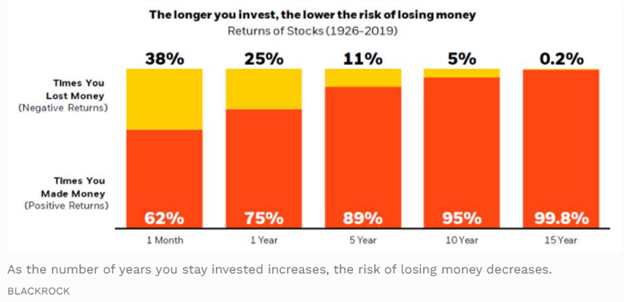Here’s Why Staying Invested in Stocks Long Term is Crucial to Building Wealth
November 18, 2022

The act of investing right now, for anyone, is clearly an unpleasant experience. That’s mainly because all we’ve seemed to see so far in 2022 is “red” in the stock market.
For anyone who has just started investing within the past year, it’s a depressing scenario. However, we should look at all this in context.
Investing is not supposed to be a “get rich quick” scheme. In fact, it’s very much the opposite in that it rewards those who are patient and disciplined.
So, for investors who may be starting to doubt their commitment to the stock market, here’s why staying invested pays off over the long term.
Think about time horizon
When we invest for the long term, we should do it with the thought of putting away capital to work for us over the next 15-20 years.
The longer, the better. That’s why industry advice regular says that individuals should not invest any money that they’ll need in the next three to five years, at least.
That way, you won’t need to pull money out of the stock market at potentially the worst possible time (i.e., when it’s down).
In the end, investing is about staying the course. That old cliché about “time in the market” is actually borne out by the data.
As you can see from the below chart from BlackRock, if you invest with a time horizon of one month then your odds of losing money are 38%. That’s pretty sizeable.

However, lengthen out that time horizon to five years and that loss percentage falls to 11%. By 15 years, it’s pretty much a certainty you’ll be in positive territory.
And although it’s not included in the visual, if you stay invested for 20 years you have a 100% chance of a positive return in the stock market.
Stay invested, don’t jump in and out
The flip side of the argument to “time in the market” is our innate urge to “time the market”. And that’s potentially lethal to our long-term returns.
Think of all the times we wished we’d either “sold then” or “bought then”, and it’s easy to understand how we think we can time it perfectly.
However, pulling all of your money out of the market and then jumping back in at a certain point in the future exposes us to real market risk.
That’s mainly down to all the data that point to how damaging missing the stock market’s best days can be to your returns.
And, to compound that is the fact that some of the market’s best days come amid a bear market.

Source: Putnam Investments
As you can from the above, from the beginning of 2007 to the start of 2022, if you had missed the market’s 10 best days, your annualised return over that period (5.05%) would have been less than half of that of someone who had stayed fully invested (10.66%).
If you missed the 20 best days over that 15-year period, you would have seen your annualised return drop to just 1.59%.
That’s why it’s so crucial that we stay the course when we invest. It’s a commitment to the long-term creation of wealth.
Investing rewards the patient
Investing most of the time can seem to be boring. It can then be punctuated by moments of sheer terror when markets tank.
It’s imperative, though, that we recall that stock markets rise over the long term. At the end of the day, investing it supposed to help us grow our money and wealth.
By sticking with it, being patient, and disciplined, all of us can ride through this rough patch and come out the other side as a better investor (and hopefully with a larger portfolio).

Tim Phillips
Tim, based in Singapore but from Hong Kong, caught the investing bug as a teenager and is a passionate advocate of responsible long-term investing as a great way to build wealth.
He has worked in various content roles at Schroders and the Motley Fool, with a focus on Asian stocks, but believes in buying great businesses – wherever they may be. He is also a certified SGX Academy Trainer.
In his spare time, Tim enjoys running after his two young sons, playing football and practicing yoga.





